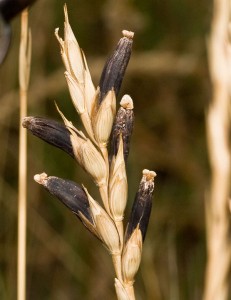
The fungus ergot turns wheat heads dark brown or purple, as seen here, and can have dire effects on cattle.
Photo by Doug Waylett
WASHINGTON— The spread of a potentially destructive fungus typically found in rye and other cereal grains may be on the rise in Iowa after a wet spring followed by intense summer heat created optimal conditions for the fungus to thrive.
The fungus, called ergot (pronounced er’-git), has been found in the southeast region of Iowa in grasses such as smooth brome and fescue and also some brome pastures in central Iowa. Experts say the economic impact is hard to gauge at this point.
“The cost depends on how many pastures or hay fields are rendered useless. There could be some impact there or for next year,” said Gary Munkvold, professor of plant pathology at Iowa State University in Ames.
Ergot can affect wheat, barley, oats, Timothy and other grasses. The effects of ergot this year cannot be easily determined yet but the fungus spread could prove troublesome for the region come winter, Munkvold said.
“I have heard of ergot-affected pastures from multiple areas of the state so it is likely going to be a statewide issue,” said Grant Dewell, beef extension veterinarian at Iowa State. “Ergot can be a problem any year but we usually don’t have a problem with it statewide in Iowa. In some cases, we may not see the effects of this until this winter when hay that is affected is fed to cattle or we may see some heat intolerance now.”
The fungus produces a dark brown or purple mass that replaces the ovary tissue in plants called the sclerotia, according to Dewell and Iowa State veterinary toxicologist Steve Ensley.
The sclerotia are often larger than typical seeds and eventually fall to the ground, creating risk of ergot fungus spread for the winter or following year.
The fungus produces toxic compounds called ergot alkaloids that can account for a 5 percent to 10 percent loss in grain yields. But extreme losses due to the fungus are rare, according to a study by pathologist Stephen Wegulo and toxicologist Michael Carlson at the University of Nebraska at Lincoln.
“If it hits your farm, the economic impacts are huge for you. You just don’t know how widespread it is going to be,” said Jason Britt, president of the Central States Commodities Inc. brokerage firm in Kansas City.
While ergot caused economic losses in south central and southeastern Nebraska in 2011, the major significance of the plant disease is the effect on animals that ingest contaminated grass and grains, Wegulo and Carlson said.
All animals exposed to the tainted grass are susceptible but cattle are especially vulnerable.
If infected, “the animals create mud wallows to try and cool off. This all cuts into the time they can graze and get nutrients so growth slows. It also creates heat stress,” said Jim Strickland, chairman of the animal and veterinary sciences department at Clemson University.
In cattle, ergot poisoning can cause the constriction of small arteries. Cattle will usually develop rough coats, experience weight loss or stand in water or shade for long periods of time. Decreased or lack of milk production can also occur and in extreme cases, gangrene can set in.
“Animals can recover if they are removed early enough before severe clinical signs are present. However, once gangrene has begun there is little that can be done,” the Iowa State University report stated.
“During the past 100 years we have made some progress in our understanding of ergot, although disease management continues to be a challenge,” said pathologist Stephen Alderman in a study for the Department of Agriculture.
Breeding for disease resistance in cereal grains has proved successful in ergot management, but experts say the effects of ergot fungus in Iowa this summer may prove to be problematic in the coming months.
